Last updated on April 27th, 2024 at 09:34 am
In order to keep my Microsoft Endpoint Manager Configuration Manager (MEMCM/SCCM) reporting guides current, I decided to write blog posts about how to install SQL Server 2019 and Power BI Report Server 2019.
Power BI Report Server is a pseudo-replacement for SQL Server Reporting Services (SSRS), so the installation process was, in fact, similar to the one for SSRS 2019 and 2017. In case you missed it, the setup, starting with SSRS 2017 is now external to the SQL Server ISO. As expected, the installation process for Power BI Report Server 2019 was similar to the 2017 version.
Please remember that you must first install SQL Server 2019 prior to installing Power BI Report Server 2019. In case you need a how-to guide, I show you the steps in, How to Install SQL Server 2019.
One thing to remember about Power BI Report Server is that not only does it allow you to view Power BI reports on-prem via a browser, BUT you also get to leverage it to display all of your existing SSRS reports too. You get the best of both worlds!
This post shows you, step-by-step, how I installed and configured Power BI Report Server 2019 in my MEMCM/SCCM current branch lab. In future blog posts, I hope to show you how to install a MEMCM/SCCM reporting services point onto a Power BI Report Server and how Enhansoft’s Power BI and SSRS reports work with Power BI Report Server.
Background
As you probably already know, Enhansoft, where I’m the Chief Architect, specializes in using SCCM/MEMCM to collect extra inventory details about computer warranties, computer monitors, local administrator and group names, etc. Once these details are all inventoried and returned to SCCM/MEMCM, our customers need to see them in easy-to-read reports in both Power BI and SSRS formats. After the reports are created, we test all of them on each version of SQL Server. I needed to setup SQL Server Reporting Services (SSRS) 2019 for a Power BI Report Server test, so I decided to put together a two-part series about how to install SQL Server 2019 and Power BI Report Server 2019. This post is the second of the two.
Even though our products provide customers with almost two hundred SSRS reports, I keep hearing requests for more Power BI reports, so guess what? Enhansoft now offers Power BI reports and we are creating new ones every week!
Licensing
Let’s get the licensing question out of the way first. Yes, there is a license cost for Power BI Report Server. So please see the official Power BI docs site for more information. No, the Power BI Report Server license is NOT included with SCCM/MEMCM SQL Server licenses (at least not yet). If you would like to obtain more details about what SQL Server licenses you get from SCCM/MEMCM, please see the official docs site.
Virtual Machine (VM) Details
I know people will ask, so below are the details about the VM I am using in my lab.
- C: 127 GB VHD – OS only.
- E: 127 GB VHD – SQL Server/SSRS/databases/etc.
- 2 Virtual CPUs.
- Enabled Dynamic Memory is set to allow for a maximum memory of 512MB to 8GB.
- Windows 2016 Datacenter is installed.
Why didn’t I split-up the databases from the SQL Server itself or from the temp databases? The simple answer is: this server never gets overloaded. All of the VHDs sit on the same RAID 10 disk, so they all share the same disk I/O. By the way, from a performance standpoint. You gain very little by adding extra VHDs to split-up the virtual disk I/O as it is limited by the physical disk I/O. IMO – adding an extra VHD wastes a TON of extra physical hard drive space, especially if the VHDs have a fixed size.
Prerequisites
The following items are required before starting the installation process:
-SQL Server 2019 is installed. You can see my post, How to Install SQL Server 2019, for detailed step-by-step instructions.
-The project key information used to install SQL Server 2019 is handy.
-The Power BI Report Server 2019 setup is downloaded.
Install Power BI Report Server 2019

To start the setup, double-click on PowerBIReportServer.msi.
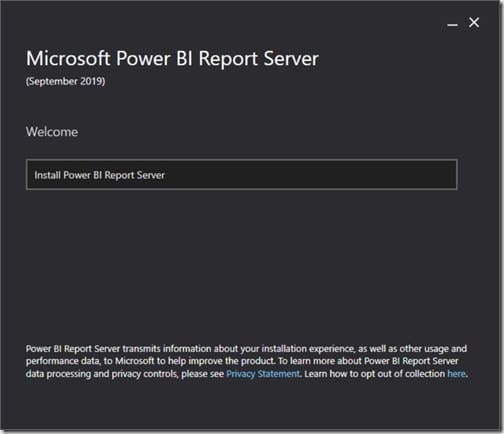
Click on Install Power BI Report Server.

Select Enter the product key and then complete the field. Click Next.
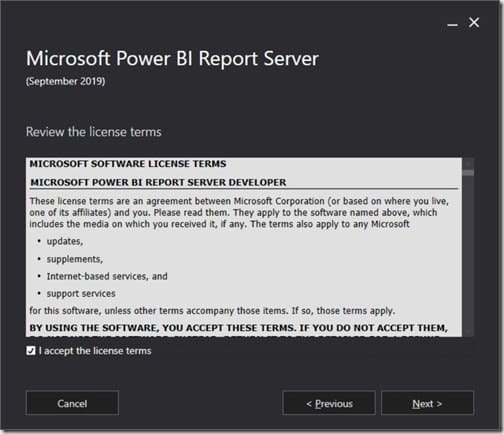
Select, I accept the license terms, and then click Next.
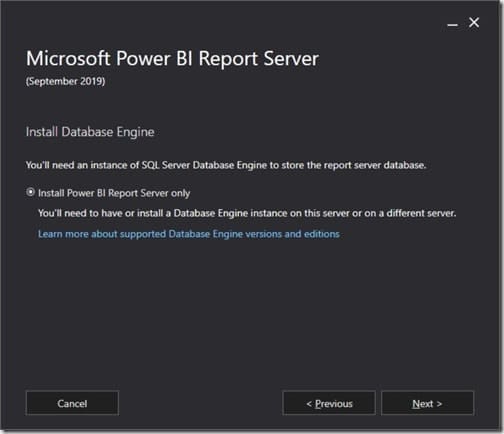
Click Next.
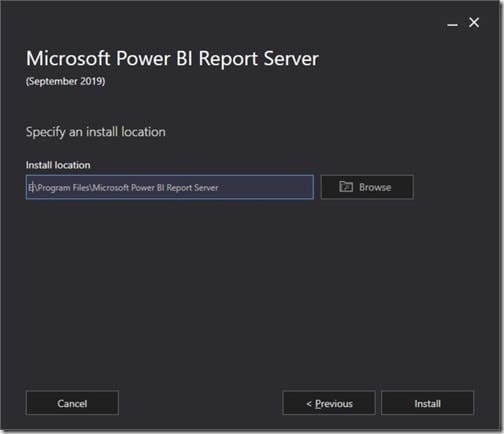
Change the install directory to E:\… and then click Install.
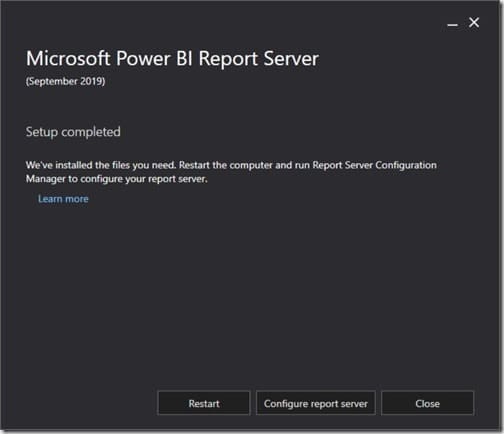
At this point you have two options: Restart or Configure report server. Keep in mind that both are required in order to complete the installation process. I decided to Restart the server first before I configured it. Do This in order to ensure that Power BI Report Server was completely installed. Before I tried to configure it.
Click on the Restart button.
Configurating Power BI Report Server

Once the server is restarted, logon and locate the Microsoft Power BI Report Server folder. Then click on the Report Server Configuration Manager link. As I mentioned in the intro, the process of setting-up Power BI Report Server 2019 is almost identical to setting-up Power BI Report Server 2017.
Note: If you don’t see the Report Server Configuration Manager icon, this means that a prerequisite was missing and you need to repeat the Power BI Report Server install again.

Click Yes on the User Account Control (UAC) prompt.
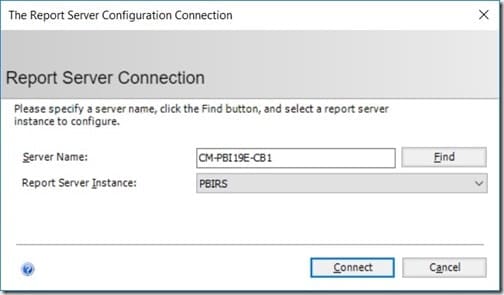
Click Connect.
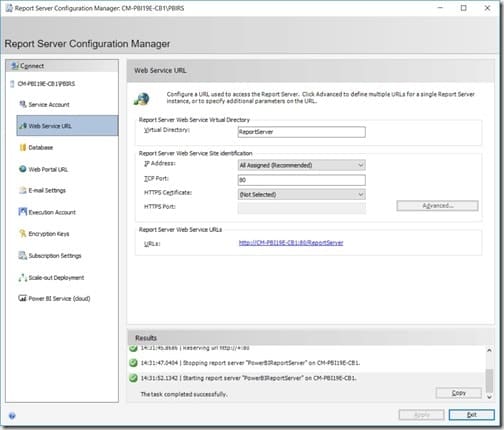
On the Web Service URL node, accept the Virtual Directory defaults and click Apply. Wait for the Virtual Directory setup to complete before clicking on the Database node.

Click on the Change Database button.
Creating Database

Accept the defaults and click on the Next button.

Click Test Connection.
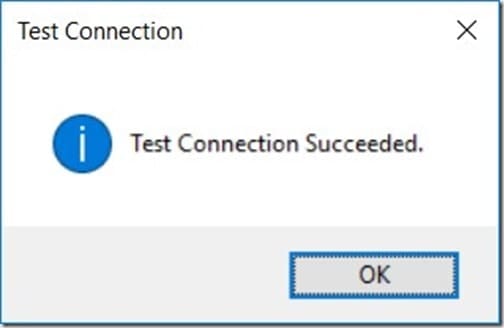
Again, Click OK.

Click Next.

Again, click Next.
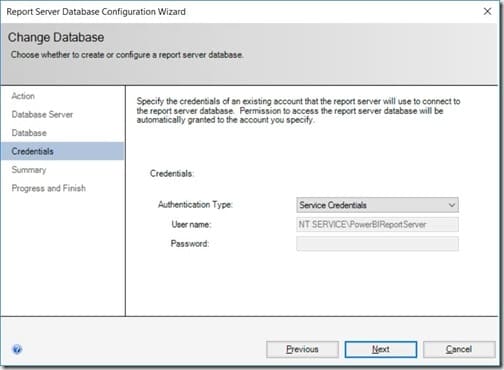
There is another click Next.

Click Next.
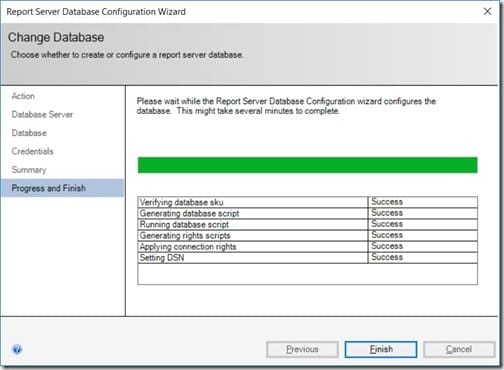
After all, click Finish.
Finishing Report Server Configuration
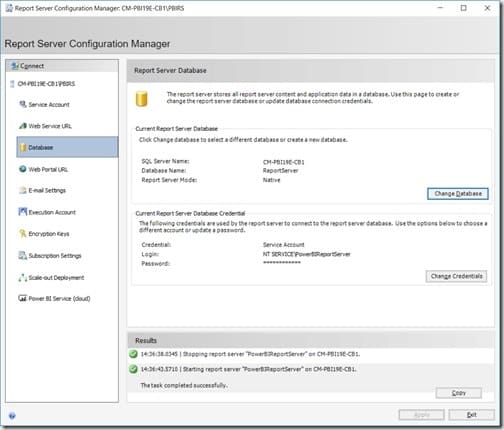
Upon returning to the main screen, wait until the message, The task completed successfully, appears in the Results pane. Next, click on the Web Portal URL node.

Accept the Web Portal URL defaults and click Apply. Wait until the message, The task completed successfully, appears in the Results pane.
At this point everything is setup for Power BI Report Server 2019. However, if you want to use email subscription, then you need to complete the E-mail Settings section. I highly recommend that you use this feature, but also keep in mind that you can change it at a later date by re-running this configuration and only updating the E-mail Settings node. Check out my post, How to Subscribe to SCCM Reports Using Office 365, for step-by-step instructions. In that post I’m using SQL Server 2016, but the steps are the same for SQL Server 2017 and 2019.
Finally, click on the Exit button in order to close the Report Server Configuration Manager window.
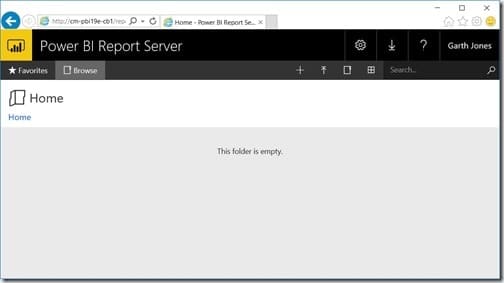
The last thing you need to do is to confirm that Power BI Report Server 2019 is working correctly. You can do this by testing the URL (https://<servername>/reports). The above screenshot shows you what a perfect Power BI Report Server site would look like. Isn’t it very similar to the SSRS interface?
With Power BI Report Server 2019 successfully installed, I can now start testing Enhansoft’s Power BI and SSRS reports in SCCM/MEMCM current branch on SQL Server 2019!
If you have any questions about how to install Power BI Report Server, please feel free to contact me @GarthMJ.
